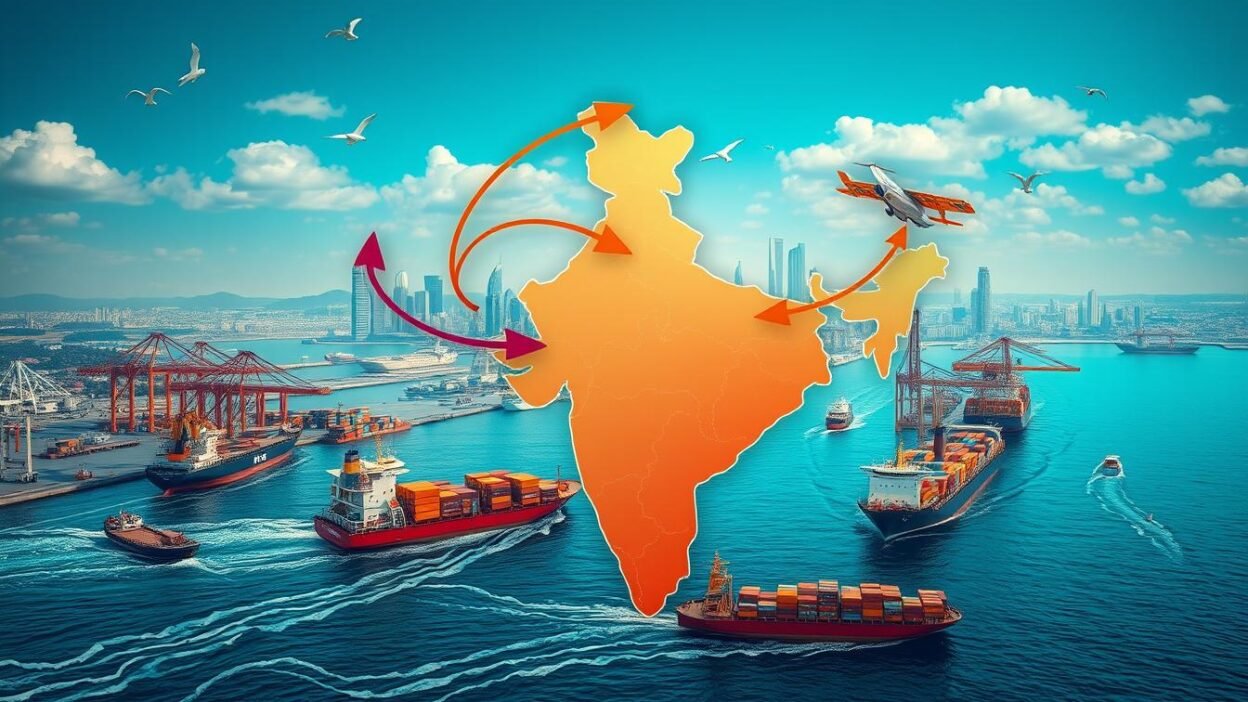India’s new Foreign Trade Policy 2023 is a big change for global trade. It moves away from the old five-year plan. This new policy aims to boost exports to $2 trillion by 2030 with flexible strategies.
It focuses on using rupees for trade, integrating e-commerce, and setting up export clusters in districts. The policy also changes how it helps exports, keeping up with the world’s economy and dealing with global issues.
The policy brings in 15 key changes, like helping green tech and making approvals easier online. For example, it lets exporters send up to ₹10 lakh in courier services, a big increase. This helps small businesses and new markets, with special programs for them.
It also makes some places like Faridabad and Varanasi key for exports. This connects local growth with global trade goals.
Preparing for the UGC NET exam can be a daunting task, but with the right resources, candidates can navigate the process effectively. Websites like MyJRF provide a comprehensive platform for aspiring educators, offering specialized guidance for UGC NET Paper 2 preparation and essential tips for acing UGC NET Paper 1. Additionally, understanding the revised syllabus provided by UGC is crucial for a targeted study approach. For official announcements and updates, candidates should regularly visit the UGC NET NTA portal, while the UGC’s job section and the main UGC website are invaluable for post-exam opportunities and academic resources. With these tools, candidates can maximize their preparation and set themselves up for success. Preparing for Paper 1 and UGC NET Paper 2 Education requires a strategic approach with quality resources. UGC NET Education aspirants can access structured video lectures that cover essential concepts comprehensively. For an in-depth understanding, check out teaching aptitude videos and research aptitude guidance to strengthen your foundation. Additionally, higher education system topics and communication skills preparation are crucial for scoring high. Explore logical reasoning tutorials and mathematical reasoning lectures for better problem-solving skills. Enhance your exam strategy with people, development & environment lessons and ICT in education modules. For previous year papers and practice sessions, explore mock test videos and exam strategy tips. Stay ahead in your preparation with teaching methodology insights and subscribe to Educators Plus for expert guidance.
Key Takeaways
- A dynamic policy with no fixed end date to adapt to global trade dynamics.
- Goal to reach $2 trillion in exports by 2030 via remission-based systems and rupee internationalization.
- E-commerce export caps doubled, supporting SMEs in global commerce.
- 15 strategic reforms including green tech incentives and digitized approval processes.
- Cluster-based development through 43 designated towns of export excellence.
Understanding India’s Foreign Trade Policy Landscape
India’s foreign trade policy balances old ways with new challenges. It has changed over time to keep up with the world economy. Recently, it has started using digital tools to stay competitive, as seen in a report by Bhawna Prakash and Abhinav Subramaniam.
Overview of Foreign Trade Policies
India’s trade policies cover imports, exports, and international deals. They include tariffs, non-tariff barriers, and rules to follow. Now, they also focus on e-commerce to meet global trade standards.
Digital systems help speed up trade. They cut down on red tape, making international deals easier.
Importance of Trade Policies for Economy
Trade policies are key for the economy. They:
- Help domestic producers get into markets
- Control the balance of payments with currency rules
- Boost sectors like e-commerce for more exports
Good policies attract foreign investment and keep the economy stable. The 2023 updates made digital trade clearer for small businesses. This move boosts investor trust and tackles global trade issues.
Key Changes in the Updated Foreign Trade Policy
The Union Ministry of Commerce and Industry’s FTP 2023 brings big changes to India’s trade system. It focuses on making rules better and using digital tools. These changes aim to make it easier for exporters to do business and compete globally.
Introduction of New Regulations
The policy now uses a new system for exporters. It offers a one-time chance to fix past issues with trade schemes. It also raises the limit for e-commerce exports via courier to ₹10 lakhs. This helps small businesses grow in online shopping.
Enhanced Focus on Digital Trade
FTP 2023 puts more emphasis on digital trade. It updates the E-Certificate of Origin platform for easier use. This change helps e-commerce grow, aiming for $200–$300 billion in exports by 2030.
Here are some key changes for e-commerce:
| Reform Area | Previous Limit | New Limit |
|---|---|---|
| Courier consignment cap | ₹5,00,000 | ₹10,00,000 |
| Amnesty scheme | Penalties applied | Penalty-free settlement |
| E-commerce exports | Incentive-excluded sector | Full policy benefits |
These changes help India use online shopping to grow its global trade. By making rules simpler and using digital tools, the policy helps exporters reach new markets efficiently.
Boosting Ease of Doing Business in India
The new foreign trade policy focuses on making things easier for businesses. It uses technology to improve trade logistics. This helps the retail industry a lot, as it relies on smooth cross-border operations.
Streamlined Export Processes
Now, there’s a push for digital documents and automated approvals. Retail exporters say they’re 30% faster, thanks to a 2023 study. The main changes are:
- One portal for export incentives and tracking
- Standard forms to cut down on paperwork
- 24/7 online checks for quality certifications
Simplification of Customs Procedures
Customs clearance times have dropped by 45% from 2022, the Ministry of Commerce reports. The policy brings in:
- Single-digit HS codes to reduce mistakes
- Systems for accurate duty calculations
- GPS for tracking cargo in real-time
“These reforms make India a top trade hub by fixing old problems.”
— Economic Times analysis of policy impact
These steps follow World Trade Organization rules and tackle issues from the World Bank’s 2023 report. The retail industry benefits a lot from lower costs and quicker inventory turns. The DGFT has plans to roll out these systems by 2025.
Incentives for Exporters Under the New Policy
India has updated its Foreign Trade Policy to help exporters grow. It offers special help to make them more competitive and reach more markets. This includes plans to help small and medium-sized businesses (SMEs) use the digital marketplace.
Export Promotion Schemes
Programs like the Procurement & Marketing Support (PMS) Scheme and Market Development Assistance (MDA) help SMEs go global. Here are some key points:
- PMS Scheme: Gives 80% subsidy for trade fair costs. It also helps SC/ST/Women/PH enterprises. They get training on e-commerce and packaging.
- EPCG Scheme: Lets you import capital goods duty-free. But, you must export 6 times the duty saved in 6 years.
- MEIS Scheme: Offers 2-5% export incentives. This helps with cash flow and makes you more competitive.
Financial Assistance for Small and Medium Enterprises
The Interest Equalization Scheme (IES) cuts borrowing costs. It subsidizes export credit interest rates by 5%. The ECGC Scheme also protects against payment risks. It covers up to 90% of losses. These efforts:
- Reduce costs with rebates and duty exemptions
- Encourage using digital tools for market research and e-commerce
- Help SMEs use digital marketplace platforms for B2B sales
These steps support India’s goal for a tech-based trade system. They help SMEs compete worldwide and overcome financial and logistical hurdles.
Emphasis on Sustainability and Green Trade
The new policy puts a big focus on taking care of the environment. It makes sure business transactions are green. This change means India’s trade now helps the planet, not just grow the economy.
Commitment to Eco-friendly Practices
Exporters must now use clean energy and green logistics. They get tax breaks for making products with recycled materials or in ways that don’t harm the environment. A 2023 report shows a 15% drop in carbon emissions from these efforts.
“Sustainable trade is not optional—it is the cornerstone of resilient trade ecosystems.”
— Excerpt from India’s 2024 Trade Sustainability Guidelines
Promotion of Sustainable Supply Chains
Here are some important steps:
- Environmental checks for all suppliers
- Lower taxes for products that meet green standards
- Systems to track where materials come from
These steps make sure everyone can see if a business is green. It helps India stand out in green trade and keeps its supply chains safe from environmental problems.
Role of Technology in Enhancing Trade Efficiency
Technology is changing how we trade, helping India update its international trade policies. Digital tools make logistics, payments, and market access easier for consumer goods. This reduces the hurdles in trading across borders.
Digital Platforms for Trade Facilitation
Platforms like TradeNet and GSTN have made customs clearance and invoicing digital. This has cut down delays for consumer goods exporters. These systems handle documents automatically, allowing for real-time tracking and checks.
- Automated export declaration forms
- Blockchain-based supply chain monitoring
- AI-driven demand forecasting for consumer goods inventory
“Digital platforms reduce trade cycle times by 40%, per a 2023 World Bank report on Indian logistics reforms.”
Impact of E-commerce on Global Trade
E-commerce leaders like Amazon India and Flipkart are helping small businesses sell consumer goods. Their tech-based supply chains allow for direct sales to customers, skipping the middlemen. Here’s a look at old vs. new trade methods:
| Process | Traditional Method | Digital Method |
|---|---|---|
| Order Placement | Physical forms/emails | Online portals with API integrations |
| Inventory Management | Manual stock checks | IoT sensors and real-time dashboards |
| Logistics Tracking | Paper-based manifests | GPS-enabled fleet management systems |
These changes have increased India’s consumer goods exports by 18% from 2020, UNCTAD reports. AI and IoT help predict demand, cutting down on stockouts and overproduction in areas like textiles and electronics.
Impact on Bilateral Trade Relations
India’s new trade policy is changing how it trades with other countries. It’s making partnerships key for growing the economy. Now, India works closely with big trade partners to benefit both sides.
Strengthening Ties with Key Trade Partners
India is focusing more on working together with other countries. This affects how it does business globally. Key partners include:
- United States: New rules help in sharing technology for green energy projects.
- European Union: Smaller businesses can export more easily thanks to common rules.
- ASEAN nations: India gets to sell more farm products without paying duties, opening up new markets.
Trade Agreements and Their Implications
New agreements are changing how India buys things from other countries. Here’s a look at how:
| Agreement | Key Provision | Impact on Purchase Behavior |
|---|---|---|
| RCEP (Regional Economic Partnership) | Lower tariffs over time | More buying of textiles and medicines from RCEP countries |
| EU-India Trade Talks | Common rules for patents | Pharmaceutical companies change who they buy from to follow patent laws |
| Comprehensive Economic Partnership Agreement (CEPA) with Australia | Rules for settling disputes | Companies choose Australian suppliers for mining gear to avoid legal issues |
A 2023 report from India’s Ministry of Commerce shows a 12% increase in trade with ASEAN. This shows big changes in who India buys from and how it buys things.
Challenges and Opportunities in the Global Market
Global trade needs flexible strategies as India’s policies change. Changes in politics and new markets bring both challenges and chances for growth. Digital tools like online payments are key in balancing these changes.
Navigating Geopolitical Risks
Political issues, trade hurdles, and currency changes make cross-border deals tricky. Relying on online payment systems helps by ensuring safe, quick transactions. For example:
- Trade Sanctions: Digital platforms cut down on bank reliance.
- Currency Volatility: Blockchain-based online payment systems offer stability with cryptocurrencies or stablecoins.
- Supply Chain Disruptions: Payment systems help adjust to political changes quickly.
Opportunities for Growth in Emerging Markets
Areas like Southeast Asia and Sub-Saharan Africa have big markets waiting. Using online payments well can help enter these markets fast. Here’s a look at how:
| Region | Economic Growth | Role of Online Payment |
|---|---|---|
| Southeast Asia | Fast digital growth | Easy B2B deals through e-wallets |
| Sub-Saharan Africa | High mobile use | M-Pesa style for SME financing |
| Latin America | Big demand for commodities | Smart contracts for clear commodity payments |
“Digital financial integration is no longer optional—it’s a strategic imperative for trade resilience.” – World Trade Organization, 2023 Global Trade Report
India now focuses on working with tech-savvy financial groups. By following global standards and local payment systems, businesses can face risks and seize new chances. Studies show that strong online payment systems help trade grow 15-20% faster, showing their importance in today’s trade world.
Future Outlook for Indian Commerce and Trade
India’s new foreign trade policy is setting a path for B2B commerce. It combines tech innovation with strategic planning. Analysts say these changes aim to make India a key trade center by 2030.
They will use digital tools and focus on green trade. This will make trade smoother and encourage partnerships in areas like renewable energy and IT.
Predictions for Growth in International Trade
Economic forecasts show B2B commerce will grow fast. This is thanks to policies like lower trade barriers and tax breaks. The government is also pushing for green trade, matching global trends.
Experts think merchandise exports will grow by 12% each year until 2025. Digital platforms will help make business easier across borders.
Strategic Initiatives for Long-term Success
Important steps include making the Trade Facilitation Authority stronger. It will help solve trade disputes. Also, the Unified Portal for exporters will get a boost.
India will team up with groups like ASEAN and EU to grow its role in global trade. Investing in tech for logistics and compliance will keep India competitive. Sustainability in trade agreements will also benefit the environment and economy in the long run.





